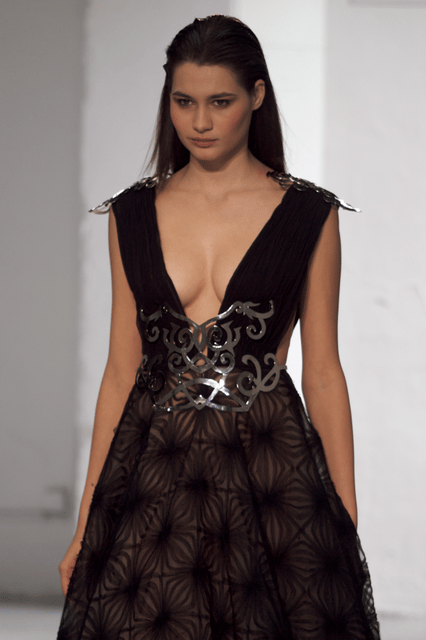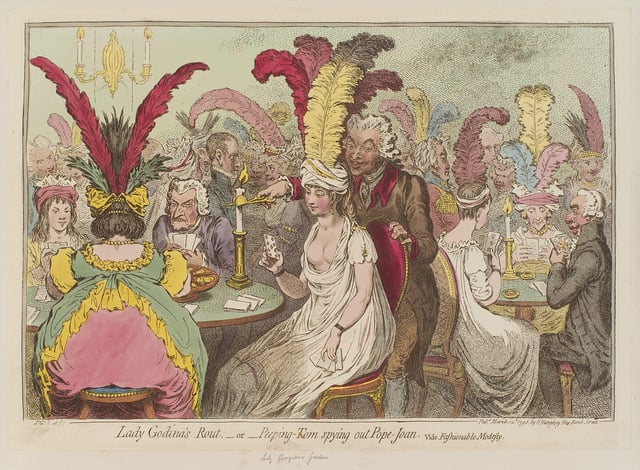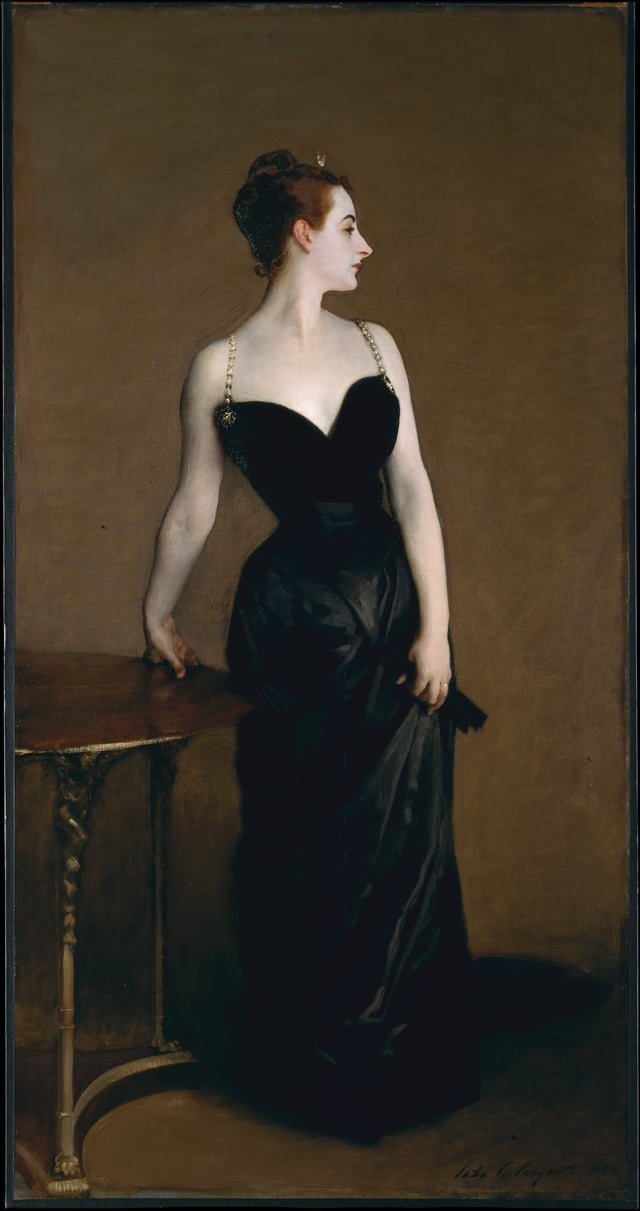Décolletage

Décolletage


Décolletage of Marie-Antoinette, Queen of France c. 1775
Décolletage /dɪˈkɒlətɑːʒ/ (or décolleté, its adjectival form, in current French) is a term used in woman's fashion referring to the upper part of a woman's torso, comprising her neck, shoulders, back and upper chest, that is exposed by the neckline of her clothing. The term is most commonly used in Western female fashions and is most commonly applied to a neckline that reveals or emphasizes cleavage. Low-cut necklines are a feature of ball gowns, evening gowns, leotards, lingerie and swimsuits, among other fashions. Although décolletage does not itself prescribe the extent of exposure of a woman's upper chest, the design of a décolleté garment takes into account current fashions, aesthetics, social norms and the occasion when a garment will be worn.
Though neckline styles have varied in Western societies and décolletage may be regarded as aesthetic and an expression of femininity, in some parts of the world any décolletage is considered provocative and shocking.
Etymology
History

Indonesian woman in traditional Javanese kemben, c. 1900.

Lady Godina's rout; - or - Peeping-Tom spying out Pope-Joan, by James Gillray, 1796.

Modern extreme décolletage revealing cleavage. (2010)

This portrait by John Singer Sargent of Virginie Amélie Avegno Gautreau depicting her cleavage caused considerable controversy when it was displayed at the 1884 Salon art exhibition in Paris.
In Indonesia (especially in Java), a breast cloth known as kemben was worn for centuries until the 20th century. Today, shoulder-exposing gowns still feature in many Indonesian rituals.
Gowns which exposed a woman's neck and top of her chest were very common and non-controversial in Europe from at least the 11th century until the Victorian period in the 19th century. Ball or evening gowns especially featured low square décolletage designed to display and emphasize cleavage.[4][5] During that long period, low-cut dresses partially exposing breasts were considered more acceptable than they are today; a woman's bared legs, ankles, or shoulders were considered more risqué than exposed breasts.[6]
In 1450, Agnès Sorel, mistress to Charles VII of France, is credited with starting a fashion when she wore deep low square décolleté gowns with fully bared breasts in the French court.[7] Other aristocratic women of the time who were painted with breasts exposed included Simonetta Vespucci, whose portrait with exposed breasts was painted by Piero di Cosimo in c. 1480.
Based on woodcut prints, a researcher has argued that during the 17th century, women's fashions with exposed breasts were common in society, from queens to common prostitutes, and emulated by all classes.[8] Anne of Brittany has also been painted wearing a dress with a square neckline. Low square décolleté styles were popular in England in the 17th century and even Queen Mary II and Henrietta Maria, wife of Charles I of England, were depicted with fully bared breasts; and architect Inigo Jones designed a masque costume for Henrietta Maria that fully revealed both of her breasts.[8][9]
In aristocratic and upper-class circles, the display of breasts was at times regarded as a status symbol, as a sign of beauty, wealth or social position.[10] From the Renaissance onwards, the bared breast even invoked associations with nude sculptures of classical Greece that were exerting an influence on art, sculpture, and architecture of the period.[9]
After the French Revolution décolletage become larger in the front and less in the back.[11] During the fashions of the period 1795–1820, many women wore dresses which bared the bosom and shoulders. James Gillray's caricature of 1796 shows Lady Georgiana Gordon (1781–1853, then only 14), not yet Duchess of Bedford, at a rout-party gambling at a game called "Pope Joan".[12] She is wearing an extreme décolletage, as was fashionable.
During the Victorian period, social attitudes required women to cover their bosom in public. For ordinary wear, high collars were the norm. Towards the end of the Victorian period (end of the 19th century), the full collar was the fashion, though some décolleté dresses were worn on formal occasions. (See 1880s in fashion.) In 1884, a portrait painting by John Singer Sargent of American-born Paris socialite, Virginie Amélie Avegno Gautreau, was criticised[13] when she was depicted in a sleek black dress displaying what was considered scandalous cleavage and her right shoulder strap fallen off her shoulder. The controversy was so great that he reworked the painting to move the shoulder strap from her upper arm to her shoulder, and Sargent left Paris for London in 1884, his reputation in tatters. The painting was named "Portrait of Madame X".[14][15]
When it became fashionable, around 1913, for dresses to be worn with what would now be considered a relatively modest round or V-shaped neckline, clergymen all over the world became deeply shocked. In the German Empire, all of the Roman Catholic bishops joined in issuing a pastoral letter attacking modern fashions.[16] Fashions became more restrained in terms of décolletage, while exposure of the leg became more permitted in Western societies, during World War I and remained so for nearly half a century.[17]
In 1953, Hollywood film The French Line was found objectionable under the strict Hays Code with some of Jane Russell's décolletage gowns being described as "intentionally designed to give a bosom peep-show effect beyond even extreme décolletage".[18] But other actresses defied the then standards. For example, Gina Lollobrigida raised eyebrows with her famous low-cut dress in 1960, and other celebrities, performers and models followed suit, and the public was not far behind. Low-cut styles of various depths are now common in many situations.
During a short period in 1964, "topless" dress designs appeared at fashion shows, but those who wore the dresses in public found themselves arrested on indecency charges.[19]
Low necklines usually result in increased décolletage. In Western and some other societies, there are differences of opinion as to how much body, and especially breast, exposure is acceptable in public.[20] What is considered the appropriate neckline varies by context, and is open to differences of opinion. In the United States, in two separate incidents in 2007, Southwest Airlines crews asked travelers to modify their clothing, to wear sweaters, or to leave the plane because the crew did not consider the amount of cleavage displayed acceptable.[21] German Chancellor Angela Merkel created controversy when she wore a low-cut evening gown to the opening of the Oslo Opera House in 2008.[22] In the 2010s, fashion which covered more of women's bodies became more popular, including higher or crew-cut necklines.[23]
See also
Backless dress
Halterneck
Topless, the baring of the whole breasts.
The hanbok worn by some 19th-century Korean mothers include a jeogori jacket so short as to bare the breasts.